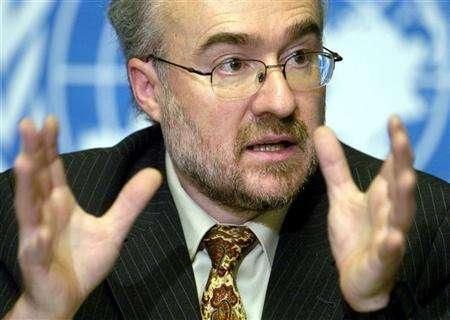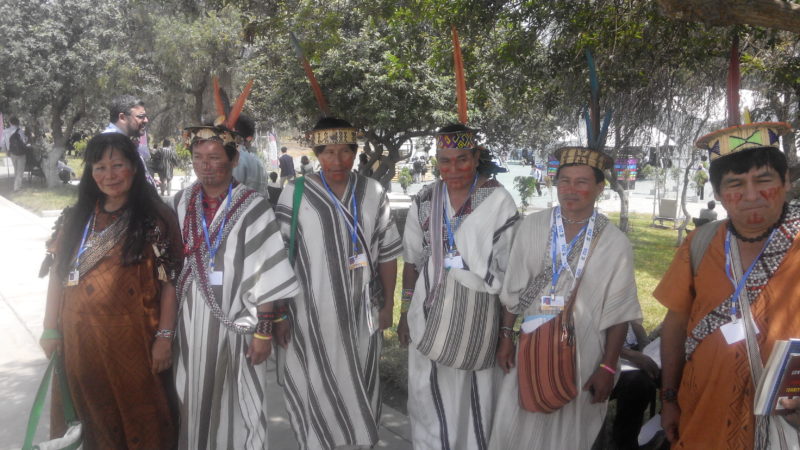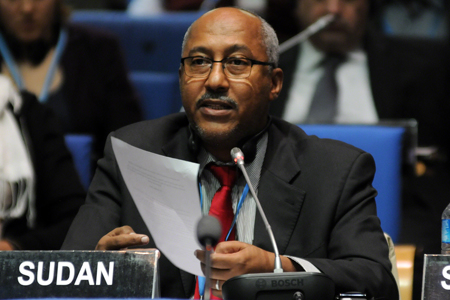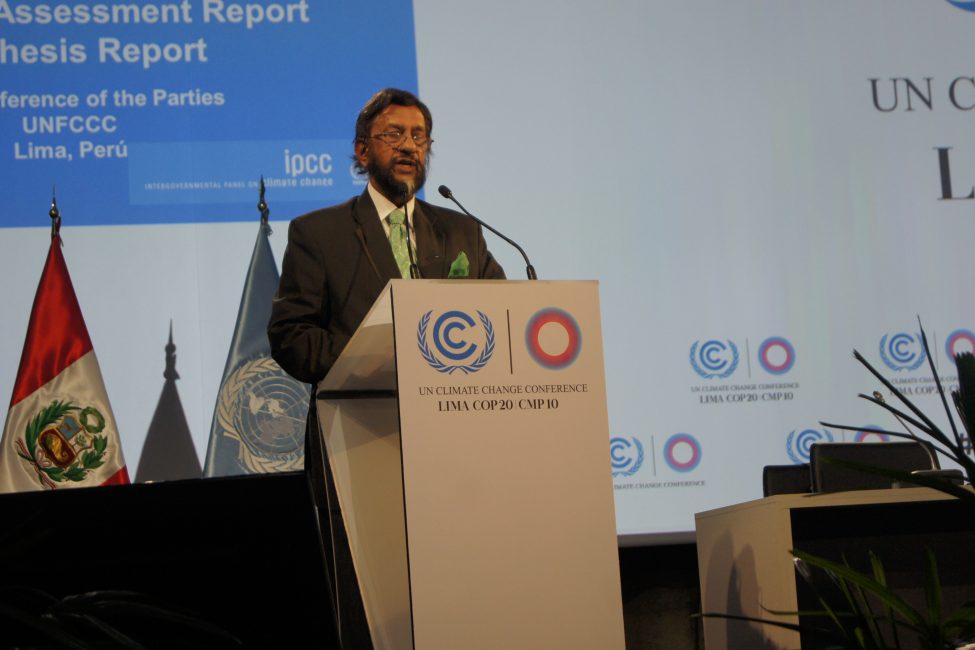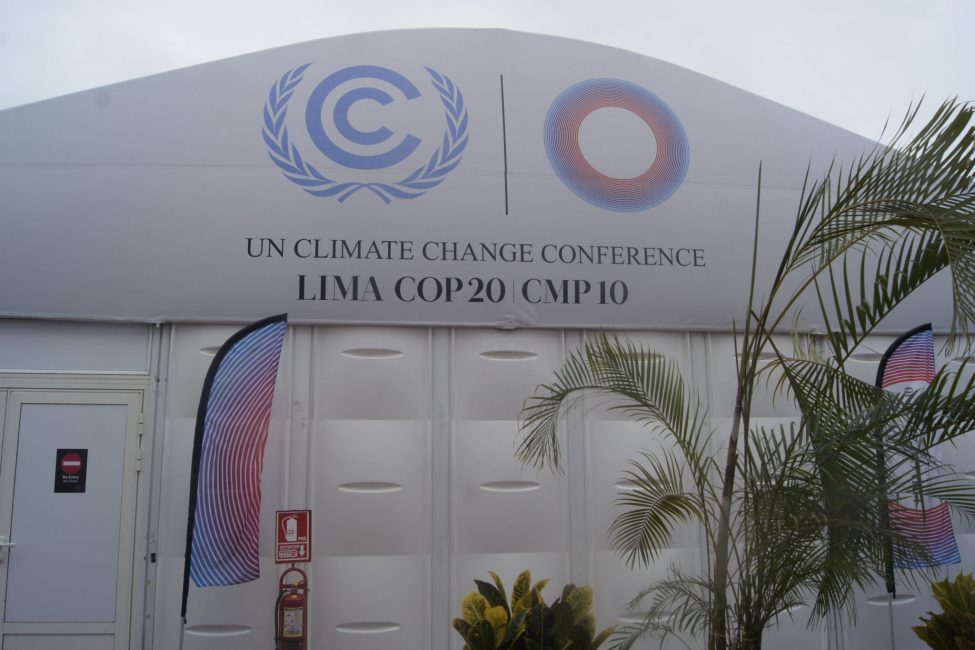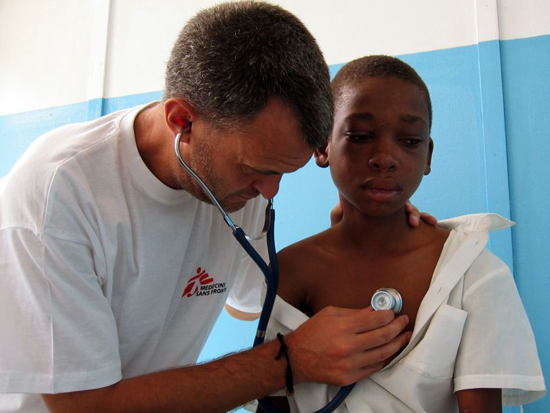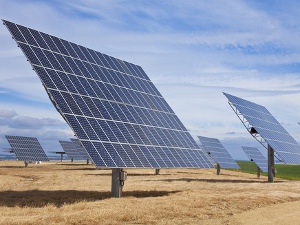D
Civil society seeks shift in private sector investment at Lima talks
Solving the problem of global climate change is impossible without huge shift in private sector investments, since this sector represents trillions of dollars with vast majority of economic activities around the world.
This is the view of Civil Society in contributing to a discussion at the ongoing climate change talks in Lima, Peru.
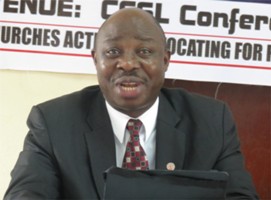
According to Dr. Thomas Jallah of the Pan-African Climate Justice Alliance (PACJA), what is needed most is policy changes and regulations particularly in developed countries “to shift private investments from brown to green”.
“National governments could do far more to shift incentives so that trillions of dollars of private investments will flow to sustainable climate-friendly activities,” he said.
Such measures, Dr. Jallah noted, may include strong legally-binding emission targets, output limit and scaling down fossil fuel power stations.
Business and industry groups attending the COP20 say they strongly support the works of the parties to address climate risks to emission mitigation and adaptation.
“We welcome the targets taken on by the EU and those announced by the US and China” said representative, Miles Austin. “We hope to see far more progress in the short term and encourage you to ensure the markets can make their fullest contribution and the private sector investment and action is capitalized to the utmost.”
The Business and Industry (BINGO) Day at the COP20 presented the activities and messages of business and industry organizations concerned about the potential impacts and opportunities presented by the negotiations.
By Kofi Adomfeh
2014 will likely be the hottest on record, WMO warns
The World Meteorological Organisation (WMO) says the year 2014 is on track for being one of the hottest, if not the hottest, on record, according to preliminary results issued at the side lines of the UN Climate Change Conference in Lima, Peru.
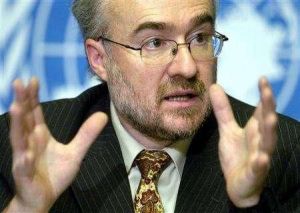
The changes, according to the estimates, are largely due to record WMO high global sea surface temperatures, which are predicted to likely remain above normal until the end of the year.
The report says high sea temperatures, together with other factors, contributed to exceptionally heavy rainfall and floods in many countries and extreme drought in others.
The high January to October temperatures, according to WMO Secretary General Michel Jarraud, occurred in the absence of a full El Niño-Southern Oscillation (ENSO).
ENSO occurs when warmer than average sea-surface temperatures in the eastern tropical Pacific combine, in a self-reinforcing loop, with atmospheric pressure systems, thus affecting weather patterns globally.
During the year, sea surface temperatures increased nearly to El Niño thresholds but this was not coupled with an atmospheric response. However, many weather and climate patterns normally associated with El Niño/Southern Oscillation (ENSO) were observed in many parts of the world.
“The provisional information for 2014 means that fourteen of the fifteen warmest years on record have all occurred in the 21st century. There is no standstill in global warming,” said WMO Secretary-General Michel Jarraud,” he says.
He adds that what was observed this year is consistent with what they expect from a changing climate.
Jarraud explained that record-breaking heat combined with torrential rainfall and floods destroyed livelihoods and ruined lives. He said what is particularly unusual and alarming this year are the high temperatures of vast areas of the ocean surface, including in the northern hemisphere.
Record-high greenhouse gas emissions and associated atmospheric concentrations according to Jarraud are committing the planet to a much more uncertain and inhospitable future.

Christiana Figueres, Executive Secretary of the UN Framework Convention on Climate Change (UNFCCC), commenting on the report expressed fears over the fact that then changing climate the risks of extreme weather events will have an increased impact on humanity.
“Fortunately our political climate is changing too with evidence that governments, supported by investors, business and cities are moving towards a meaningful, universal climate agreement in Paris 2015”
She explained that an agreement that keeps a global temperature rise below 2 degrees C by putting in place the pathways to a deep de-carbonisation of the world’s economy and climate neutrality or ‘net zero’ in the second half of the century is urgently needed.
WMO’s provisional statement on the Status of the Global Climate in 2014 indicated that the global average air temperature over land and sea surface for January to October was about 0.57° Centigrade (1.03 Fahrenheit) above the average of 14.00°C (57.2 °F) for the 1961-1990 reference period, and 0.09°C (0.16 °F) above the average for the past ten years (2004-2013).
The reports says if November and December maintain the same tendency, then 2014 will likely be the hottest on record, ahead of 2010, 2005 and 1998. This according to Jarraud and his forecasters confirms the underlying long-term warming trend.
Highlights from the Statement:
Land surface temperatures
Average surface air temperatures over land for January to October 2014 were about 0.86°C above the 1961-1990 average, the fourth or fifth warmest for the same period on record.
Western North America, Europe, eastern Eurasia, much of Africa, large areas of South America and southern and western Australia were especially warm. Cooler-than-average conditions for the year-to-date were recorded across large areas of the United States and Canada and parts of central Russia.
Heatwaves occurred in South Africa, Australia and Argentina in January. Australia saw another prolonged warm spell in May. Record heat affected northern Argentina, Paraguay, Bolivia and southern Brazil in October. Notable cold waves were reported in the U.S. during the winter, Australia in August and in Russia in October.
Ocean heat
Global sea-surface temperatures were the highest on record, at about 0.45°C above the 1961-1990 average.
By Wambi Michael
Christiana Figueres: Climate finance flowing, but inadequate
Climate financing across the globe has hit record high to about $650 billion in the last two years, but UN climate chief Christiana Figureres says it is not enough to meet the growing financial needs to tackle global warming.

A new financial assessment report presented to at the UN Climate Change Conference in Lima, Peru puts the lower range of global total climate flows at $340 billion a year for the period between 2011 and 2012.
The assessment, compiled by the UNFCCC standing committee on finance, is the first to put together information and data on financial flows supporting emission reductions and adaptation within the countries and through international support.
Support from developed countries according the assessment amounted to about $35 billion dollars and $50 billion annually, within the multilateral development banks.
Flows from dedicated multilateral climate funds –including UNFCCC funds represented $0.6 billion- which was the smallest share contributed during the period. The flow according to the assessment does not figure pledges for the Green Climate Fund amount to nearly $10 billion.
Figueres, the UNFCCC Executive Secretary, while launching the report said: “Finance will be crucial key for achieving the internationally-agreed goal of keeping a global temperature rise under 2 degree C and sparing people and the planet from dangerous climate change.”
She however noted that the flows were an indication of optimism that climate financing should be in the trillions of dollars if the world is to make the transformation it needs in the timely fashion. “We will get to the trillions only if we leverage private sector and private capital flows,” said Figueres while addressing journalists.
She said understanding how much is flowing from private and public sources, how much is leveraging further investments and how much is getting to vulnerable communities including for adaptation is vital for ensuring adequate financing for global transformation.
Commenting on the source of financing, Figueres said it was heartening to note that the money was coming from multiple sources through different channels all aimed at addressing climate change. “Because it is not realistic that all the climate finance we need will come from one particular source or one channel,” she said.
She hoped that financing of climate change permeates the global financial system and becomes a global component of the global finance.
One negative part of the assessment is that most of the money was flowing towards mitigation interventions and less toward adaptation. Also the assessment shows that Africa and small Island states were also receiving less share of the adaptation financing.
Seyini Nafo, a delegate from Mali, who is also a member of the Standing Committee of the UNFFCC, in the presentation indicated that only five percent of the global financing was getting to adaptation with a whopping 95 percent targeted towards mitigation.
Figueres noted: “There is no doubt that adaptation finance needs to increase. Because that is the urgency among most developing countries to cover their adaptation cost because many developing countries are putting their own money in adaptation financing because they don’t have any other source and they cannot wait for international climate flows,” she noted.
By Wambi Michael
‘Selling off forests is business for Peruvian government’
New report finds that Peruvian government is failing to address the real causes of deforestation in the Peruvian Amazon while undermining indigenous peoples’ efforts to protect their forests
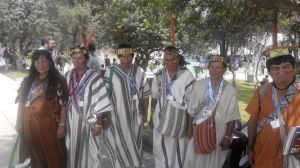
A new report has shown that, despite public commitments to protect Peru’s forests, the first Amazonian host of the UN COP is ignoring the real drivers of deforestation and failing to safeguard the rights of indigenous peoples. This, despite the fact that these peoples occupy approximately one third of the Peruvian Amazon and offer the best chance of defending the country’s precious forests.
The report, Revealing the Hidden: Indigenous Perspectives on Deforestation in the Peruvian Amazon, was compiled by Peru’s national indigenous peoples’ organisation, AIDESEP, and an international human rights organisation, the Forest Peoples Programme (FPP). The findings are based on the analysis of Peru’s indigenous leaders and organisations, whose peoples, lands and livelihoods are threatened by deforestation on a daily basis.
Contrary to official discourses that blame migrant farmers for deforestation, the report suggests that the “invisible” drivers of current and future deforestation in Peru include road construction, oil, gas and mining projects, palm-oil plantations, illegal logging operations and mega-dam projects. The report revealed that official analyses of deforestation have placed disproportionate responsibility on migrants from the Andes, while downplaying the crucial role of decades of road construction and explicit colonisation programmes on the part of the government. These schemes actively promoted immigration and were aimed at the economic integration and agricultural development of the Amazon. As a result, according to the authors, an estimated 75% of deforestation in Peru occurs within 20km of a road.
Indigenous defense of the Amazon
Meanwhile, the contributions of indigenous peoples, who continue to protect their ancestral lands from invasion by colonists, illegal loggers and miners, are being disregarded or, at worst, undermined.
The threat to indigenous peoples and lands became all too real to Edwin Chota and other leaders of the Ashéninka community of Saweto in Ucayali when they were murdered in September 2014, allegedly by logging mafia, in reprisal for their longstanding efforts to protect their lands from illegal logging and to secure title to their territory.
“It makes me furious,” said Marcial Mudarra, the President of CORPI, an indigenous organisation in San Lorenzo, speaking about the murders. “Selling off the jungle is a business for the state, but the price is the death of our Ashéninka brothers, who had been denouncing the loggers and protecting their lands. The government closed its eyes and became deaf, blind and dumb. Only when they were dead did it start to take action.”
The consistent failure of the Peruvian government to provide protection for Chota in the face of death threats and to legally recognise Saweto’s lands despite years of determined advocacy mirrors the experience of many other indigenous communities. The report shows that the territorial demands of at least 1174 indigenous communities remain pending, part of an estimated 20 million hectares of indigenous territories with no legal guarantees. Instead, the Peruvian government continues to approve overlapping mining, timber and oil and gas concessions, and to undermine these territories with laws that violate Peru’s human rights obligations.
Despite such challenges, Peru’s indigenous peoples continue to successfully protect their forests. The report documents their diverse efforts to resist land invasions, illegal logging and poaching and the imposition of oil and gas projects. Many have embarked on small scale initiatives to produce coffee and cocoa and practise low-intensity logging in harmony with their forests.
The report reports the latest data on deforestation in Peru. As reflected in recent global studies, rates of deforestation in indigenous territories are significantly less than overall deforestation rates, and more than 75% of all deforestation in Peru takes place outside the boundaries of indigenous territories and protected areas.
Although the government has acknowledged the contributions of indigenous peoples to forest conservation, its support for further recognition of indigenous lands and community forestry remains only on paper, while indigenous efforts to protect forests continue to be undermined by weak and contradictory laws and by political persecution.
Ignoring the real drivers of deforestation
The report estimates that, in 2013, at least 20% of deforestation in Peru was attributable to illegal gold mining in Madre de Dios and to oil-palm developments in Loreto and Ucayali. These rates of deforestation are projected to increase massively, with at least 100,000 hectares of forest in Loreto requested for oil-palm development and over 50 major dams (each more than 100MW in capacity) in planning stages, and threatening to flood thousands of hectares of forest and displace its indigenous inhabitants.
“Despite this huge expansion, oil palm is not discussed much in these debates about deforestation,” said Alberto Pizango Chota, President of AIDESEP. “It is ‘invisible’, just like the massive oil spills, the multiple dams that are planned, the super highways, the gold rush and the timber mafia. This official silence shows the need for this study – the need to make visible what is not spoken and to expose what is hidden.”
For indigenous peoples, who live in and depend on these forests, the impacts of this development model are often devastating, as shown by the health and environmental disasters recently declared in the Tigre, Corrientes, Maranon and Pastaza river basins, after 40 years of oil operations.
Many of the new developments are taking place at the behest of powerful criminal organisations, often associated with corrupt government officials. For example, a senior figure at the Ministry of Energy and Mines was exposed in 2012 for his part-ownership of a major gold exporter, which was sourcing gold from Madre de Dios, where an estimated 97% of all mining is illegal.
“In the La Pampa area, 30,000 miners are controlling the military commanders, the police and the judges,” said a leader of COHARIYMA, an indigenous organization in Madre de Dios. “The police earn miserable wages, yet now they have big houses and luxury 4-by-4s. Officials pretend they’re intervening, but in reality they do nothing.”
The report identifies systematic bias in Peru’s land-use planning, which consistently favours large-scale extractive developments, particularly oil, gas and mining projects over environmental considerations and the rights of local communities and indigenous peoples. This is exemplified by the reduction of the Ichigkat-Mujat National Park in favour of mining interests in 2007.
“MINAM [the Ministry of Environment] was created with the objective of protecting the forest but instead it is bargaining with these resources,” said Teobaldo Chamik, a Wampis leader from the Santiago River. “Our territory and its resources have become a business to hand over to investors and capitalists. The government creates the protected areas … but the same government then overlaps these areas with mining and oil concessions.”
A genuine commitment?
The 20th Conference of the Parties to the UN Framework Convention on Climate Change is holding in Lima and Peru is hoping to establish itself as a leading player in the fight to protect tropical forests and indigenous peoples’ rights as part of a broader commitment to mitigating climate change. Indeed, the country has made unprecedented public commitments in recent years to protect its forests, including a pledge in 2010 to cut net deforestation to zero by 2020.
President Humala reiterated this pledge in September 2014 and announced a major agreement with Germany and Norway to finance and support this vision. Nevertheless, the announcement came hot on the heels of a law (Ley 30230) passed in July to promote investment, while significantly weakening Peru’s already feeble environmental laws. More seriously, the new measure seems to allow the seizure of indigenous lands in order to facilitate large-scale development projects.
The report outlines key steps that could be taken to address deforestation and the violation of indigenous peoples’ rights. These include:
- Resolve indigenous peoples’ territorial demands, alongside respecting their right to determine their own development paths,
- Provide legal, financial and technical support to implement this vision.
- Close legal loopholes that continue to permit forest destruction, controlling illegal practices, and
- Implement robust and independent planning mechanisms to ensure economic interests do not trump all other considerations.
“Peru is at a cross roads,” said lead author Michael Valqui from the University of Cayetano Heredia’s Centre for Sustainability. “The pledges have been made, the solutions exist, and the funds are available, but the will appears to be missing, as long as the government continues to ignore the real causes of forest destruction”.
Sadly, Peru is by no means a unique example. A detailed assessment of nine countries reveals a growing crisis in the world’s forests, and a spike in violations of the rights of indigenous peoples and forest-dependent communities. The findings suggest that climate change mitigation and conservation policies must place community land rights and human rights centre stage if they are to achieve the goal of effectively and sustainably reducing deforestation. A review of the findings will be launched in Lima on the 8th December, at a hearing in the presence of the UN rapporteur on the rights of indigenous peoples.
Africa demands ratification of KP2 extension at Lima talks
The African Group of Negotiators on Climate Change has urged developed countries to ratify an extension of the second phase of Kyoto Protocol (KP). They say the developed nations must show leadership in tackling climate change effects by ratifying the binding treaty.
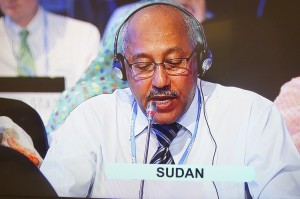
Nagmeldin G. Elhassan, the Chair of the African Group of Negotiators, says ratifying the second commitment period is the only way Africa and developing nations can take the developed countries seriously on commitments to reducing greenhouse gas emissions.
Elhassan says by ratifying the agreement, the developed countries will build confidence among African countries suffering the brunt of climate change that they are committed to reducing the suffering of the people due to climate change.
“We would like to encourage all parties to speedily ratify the second commitment period of the Kyoto Protocol to show progress under the new legal agreement under the Durban Platform for Enhanced Action (ADP). That will be amicable to all parties. But what we have observed is annex 1 party is reneging, abandoning and weakening the commitment of the Kyoto protocol.”
Ratifying the agreement legally binds rich nations responsible for industrial pollutions to cut their emissions of climate-damaging greenhouse gases under specified targets of 15 to 30 per cent by 2020 and 60 to 80 per cent by 2050.
They can either do this obligation directly or indirectly by helping developing countries with the required finance for capacity building, adaptation, mitigation and technology transfer among others.
Though the second commitment period of the Kyoto Protocol – an international treaty that is binding on industrialised countries to reduce GHG emissions – began in 2013, it is not yet ratified by many developed countries. So far, only 14 countries from developing and developed nations have signed and ratified the treaty.
In Doha (Qatar) in 2012, the following countries agreed to a further commitment period under the Kyoto Protocol: Australia, the EU, Croatia, Iceland, Liechtenstein, Monaco, Norway and Switzerland.
Major emitters such as China, USA, Russia, India, Japan, Brazil, Canada, Mexico, Indonesia, South Korea and South Africa announced politically binding reduction targets to be achieved by 2020 under the Convention.
Elhassan says failure to ratify the treaty by the developed nations is frustrating progress already achieved in combating climate change effects.
Samual Samson Ogallah of Pan-African Climate Justice Alliance (PACJA) says the non-committal stance of annex 1 countries to the treaty and other historical obligations accounts for the frustrations African group and the civil society keep experiencing in various COP meetings.
Ogallah says such frustrations and shifting of goal posts led to the civil society walkout from the 2013 COP Meting in Warsaw, Poland. He encouraged the African negotiators to press forward without relenting.
The appeal comes at a time the Intergovernmental Panel on Climate Change (IPCC) is warning of the worst climate ahead. Dr. Rajendra Kumar Pachauri, the IPCC chair, told delegates in Lima that the case for prioritising action on climate change was clearer than ever before but not much is being done to reduce global temperature.
He said the Fifth Assessment Report (AR5) uncovered the fact that mankind was responsible for the increase in air and sea temperatures, now responsible for adverse impacts across all continents.
The report says the oceans have absorbed most of the extra heat that has been observed over the last 10 years, leading to a general rise in water temperatures.
Elena Bardram, head of the EU’s international carbon market unit, says the developed nations will continue complying with earlier commitments to addressing challenges of climate change. She says Finance will continue being consolidated as required to tackle some of the challenges in additions to implementing carbon emission cuts.
Meteorologists warn of El Nino over East Africa
Few days after the Intergovernmental Panel on Climate Change warned of worst climate ahead, East African Meteorologists have moved to issue El Nino alert over the region.
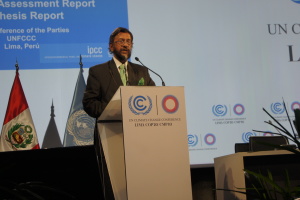
Uganda National Meteorology Authority is calling for preparation of the members of the public for the occurrence of the adverse weather event. According to the alert, El Nino is expected to occur between December 2014 and February 2015.
El Niño is a weather condition characterised by unusually long rainfall conditions with the possibility of flooding and landslides.
Jackson Rwakishaija, the Acting Executive Director Uganda National Meteorological Authority, says there are adequate factors putting the probability of occurrence at up to 70 percent. He says the Pacific Ocean has shown renewed signs of El Nino development in recent weeks adding that, above average temperatures in the tropical Pacific Ocean typical of El Nino conditions have warmed further in the last fortnight.
The World Meteorological Station concurs with the authority. It says the Southern Ocean Oscillation Index has generally been in excess of El Nino thresholds in the past three months. According to Rwakishaija, not all factors responsible for development of El Nino have been satisfied. He says regardless of whether or not El Nino fully develops, warmer than average tropical Pacific Ocean temperatures combined with cooler waters currently observed to the north of Australia increases the chance of El Nino like impacts over the East African region.
Rwakishaija concludes that this suggests above average rainfall during the month of December and January over Uganda. The authority warns that when the predicted El Nino comes, it will be stormy accompanied by strong winds and sometimes hail stones. Uganda’s capital Kampala has been experiencing heavy rains in recent weeks that resulted into flooding. El Niño conditions tend to occur once in every five years.
The last severe El Nino in Uganda occurred in 2006, causing massive flooding in Teso, Lango and Acholi regions. Mountainous areas like Sironko, Kapchorwa, Mbale, Bundibugyo and Kabale face the increased risk of landslides during severe El Nino. The Alert comes as the Intergovernmental Panel on Climate Change has warned the world of the worst climate conditions ahead.
Dr. Rajendra Kumhar Pachauri, the head of United Nations Intergovernmental Panel on Climate Change (IPCC), told negotiators at the Lima climate talks that the increase in temperatures observed in 2014 is much more than any observed in the last 10 years. Currently, planet earth is experiencing a phenomenon known as global warming of 0.8 Celsius degrees increase in temperature.
The increase climate scientists warned is bad enough to trigger many adverse weather conditions across the world. The cautions have triggered a series of coordinated actions including reductions in emissions of industrial greenhouse gas to prevent the temperature increase hitting the 1.5 Celsius degree mark by the end of the century.
Back in the East Africa region, the Kenya Meteorological Department has also reported that there will be enhanced rains in many parts of the country till next year.
James G. Kongoti, the acting Director of Kenya Meteorological Services and permanent representative of Kenya at the World Meteorological Organisation (WMO), says the October to December season indicates that much of the country is likely to experience enhanced rainfall.
He attributes this to the expected evolution of global sea surface temperatures that is favourable for the development of a weak El Nino during the season. According to the Kenya Meteorological Department, the sea surface temperatures off the East African coastline are expected to revert to neutral conditions early in the season.
The findings have been consistent with earlier measurements. In August, the Kenya Red Cross Society (KRCS) appealed to the national and county governments to adequately prepare for the El Nino rains expected by October this year.
KRCS Chief Executive Officer Abbas Gullet said with the rains experienced in recent weeks, signs were clear that Kenya will have El Nino rains later this year. “We already know the October-November short rains will have an El Nino effect. The rains we have been getting a few weeks ago are freak rains which are a precursor to the main El Nino,” he cautioned.
“How prepared are we all the time… whether it’s a county government or a central government? So we don’t want to be shocked when we see those pictures,” he warned.
According to Gullet – whose society has been at the forefront in providing humanitarian aid in drought or flood hit areas – the El Nino warning should be taken seriously right from the national government to the counties to alleviate the effects that come with heavy flooding.
In October, United Nations scientists urged preparation for weather-disrupting El Niño phenomenon which they said recur after every two to seven years. They said the warming of parts of the Pacific Ocean in 1997-98 changed the patterns of the wind and moisture overhead, resulting in severe weather around the world.
The climate disaster that swept through the horn of Africa region also affected Kenya. It was blamed for thousands of deaths in storms, heat waves, fires, floods, frost and drought. Property damage was at least $32 billion.
“The 1997-98 event was a wake-up call,” said Michael Glantz of the National Center for Atmospheric Research in Boulder, Colo.
“Awareness of what El Niño can do to societies and economies is now high,” said Glantz, a longtime El Niño researcher and senior author of the report. According to the UN scientist, the government of Peru saved the day when it formed a task force to coordinate activities and went to the World Bank for money to clean up rivers and canals and shore up bridges and roads a head of the 1997-98 El Nino.
On the other side of the coin, he said, Kenya had the forecast in June of 1997 and the government didn’t act on it. “When heavy rains came, roads collapsed, train routes collapsed, bridges, etc.,” he said.
It may be that the forecast influence of El Niño on Kenya was less clear to officials, he said, but by organising regional groups to prepare and increasing education this can be overcome.
By Peter Labeja
Extreme heat, discordant tunes reign at Lima climate talks
Delegates from over 190 countries at the ongoing Lima global climate talks have, ironically, come under serious pressure from the weather with extreme heat trailing the negotiations. As negotiations opened on Monday morning, delegates immediately found themselves on the hot seat as IPCC chair Rajendra Pachauri challenged delegates to “come to terms” with the fact that staying below the 2°C target requires zero or negative emissions, relative to 2010 levels, by 2100.
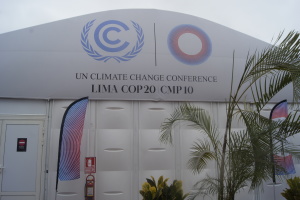 The literal heat of the venue prompted one delegate to exclaim: “This is just like a greenhouse and this is exactly what’s happening to our planet.”
The literal heat of the venue prompted one delegate to exclaim: “This is just like a greenhouse and this is exactly what’s happening to our planet.”
“Last October, those of us who were at the Convention for Biological Diversity COP in Pyeongchang, South Korea, were subjected to cold temperature extremes; now we’re being tried by fire,” complained another.
Yet, while many took off their jackets following the COP President’s exhortation, one observer lamented: “The generic opening statements did not signal that delegates were ready to roll up their sleeves.”
Some participants suggested that Lima’s success will hinge on the “long overdue fulfilment of promised leadership roles,” with others pointing to “positive signals” of emission reduction or limitation targets announced by the EU, the US and China, and the pledges of US$9.7 billion for the GCF.
“The heat is on,” said Sam Ogallah of the Pan-African Climate Justice Alliance (PACJA). “We’ll see if these signals will restore trust and facilitate progress toward an agreement in Paris over the next two weeks.”
Expressing concern on the pressure from the climate in Lima, Xolisa Ngwadla, Africa’s lead negotiator on the new legal agreement, averred that “the 2C global goal poses a lot of risks for Africa. The IPCC has showed that 2C of warming means substantial adaptation measures are needed in Africa to ensure food security and support sustainable development.”
“Given those risks, adaptation must be central to the post-2020 agreement and we need far greater transfers of finance and technology to countries who are particularly vulnerable to adverse effects yet have little historical responsibility for climate change,” Ngwadla added.
“I’m afraid this conference may end up in failure, just like Copenhagen,” PACJA’s Robert Chimambo thundered. “Divisive strategies and trump cards such as the Intended Nationally Determined Contributions (INDCs) being proposed by developed countries confirm our initial fears in Africa that this conference has been pre-planned to fail.”
In addition to the heat pressure and discordant tunes coming out from Lima is the apparent absence of common agreement on what constitutes climate finance. Japan has spent $1 billion of its climate financing on new power plants in Indonesia that burn coal, saying it improves the environment because the new plans burn cleaner, but according to an activist with the Global Campaign to Demand Climate Justice, Alex Rafalowicz, “coal, or any dirty and harmful energy has no place in climate finance.”
The U.N.’s weather agency is expected to present temperature data showing 2014 could be the hottest year on record. Peru is among the countries most affected. The Andean nation has 70 percent of the world’s tropical glaciers, which have lost more than a fifth of their mass in just three decades, putting 300,000 highlanders under severe stress as pastures and croplands dry up, the planting cycle becomes more erratic and cold snaps more severe. Lima is the world’s second-largest desert capital after Cairo, Egypt, and its 10 million inhabitants depend on glacial runoff for hydropower and to irrigate crops.
The degree to which Lima talks will succeed will depend on the capacity of the negotiators to harmonise separate action plans from up to 190 countries into a single acceptable and workable agreement. If the talks are to succeed, they will have to come up with a draft text that outlines the structure of that agreement – how to ensure countries commit to deep enough cuts to limit warming to the 2C goal, and how to verify their actions.
The US is pushing for a deal that would avoid setting emissions reduction targets that are legally binding under international law, because that would set up a clash with congress. Many developing countries, however, insist on legally binding targets. They also argue that only the industrialised countries should have to cut emissions.
By Atayi Babs (PAMACC)
Clean water, sanitation vital in treatment for people living with HIV
Access to clean water and basic toilets is an essential but neglected part of the management and treatment of human immunodeficiency virus (HIV), new research by international development organisations WaterAid and SAfAIDS has found.
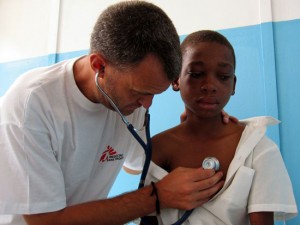
The new report shows that 70% of the approximately 35 million people living with HIV in the world reside in Sub-Saharan Africa. This equates to approximately 25 million people.
Clean water is critical to keeping people living with HIV healthy, for taking antiretroviral (ARV) drugs and for the good hygiene required to minimise infections. Yet 35% of people in sub-Saharan Africa are living without access to clean water and 70.4% are without basic sanitation. This leaves many people living with HIV suffering from chronic diarrhoea and unable to care for themselves or their families.
Diarrhoea compromises the effectiveness of ARV drugs by reducing the body’s ability to absorb nutrients from food and medicine. Many life-threatening opportunistic infections are caused by exposure to unsafe drinking water, inadequate sanitation, and poor hygiene.
Diarrhoea is a very common symptom that can occur throughout the course of HIV and AIDS and affects 90% of PLHIV resulting in significant morbidity and mortality. 88% of diarrhoeal cases are directly linked to unsafe drinking water, inadequate sanitation and poor hygiene.
Dr. Michael Ojo, WaterAid Nigeria Country Representative, said: “Thanks to the great strides in medical research over the last three decades, HIV is now a much more manageable condition and no longer the death sentence it used to be. It seems to be counter-productive that in spite of such progress on education and in delivering anti-retroviral drugs, there’s no focus on ensuring people living with HIV/AIDS also have clean water, basic toilets and the means to wash themselves and keep their surroundings clean. These basic services are crucial in helping those living with the illness to lead healthier, more dignified and more productive lives.”
Lack of access to clean water nearby means many households have more than a kilometre to walk for water, and people living in households without toilets, including the sick and elderly, have no choice but to defecate in the bush.
Taking ARV drugs requires 1.5 litres of safe, clean water each day. However, a person living with HIV might require up to 100 litres a day to stay clean and healthy. This takes into account basic needs for drinking, food preparation, laundry and washing, as well as for formula-feeding babies born to mothers with HIV, for watering gardens to improve nutrition, and for extra cleaning, washing and laundering during cases of diarrhoea. In many parts of sub-Saharan Africa, this is simply not possible.
The report recommends combining water, sanitation and hygiene into HIV services to recognise that without sufficient clean water, sanitation and proper hygiene, people living with HIV will be more ill more often, and less able to live healthy and productive lives.
Lois Chingandu, SAfAIDS Executive Director, said: “If the world does not prioritise water and sanitation hygiene issues, all gains made in the HIV response will be reversed. Concerted efforts must be made to ensure the existing linkages are given the attention and prominence they deserve.”
With less than a year until UN member states agree the new Sustainable Development Goals (SDGs), WaterAid and sector partners are calling for a stand-alone goal on water and sanitation. Universal access to water, sanitation and hygiene services, already recommended in the initial draft, will play a critical role in supporting health targets such as eliminating AIDS by 2030.
WaterAid also calls for proposals around universal health coverage to include environmental factors such as water, basic toilets and good hygiene education within households. For people living with HIV, this would help to prevent opportunistic infections and enable healthier, more productive lives.
Welcoming Smart Villages Initiative to Africa
“Aid cannot achieve the end of poverty – ‘only homegrown development based on the dynamism of individuals and firms in free markets can do that.” – A former World Bank economist.
 Electricity is development. It is something without which development is a mirage. Very many African villages lack electricity because all African countries cannot provide this essential commodity for use by rural dwellers.
Electricity is development. It is something without which development is a mirage. Very many African villages lack electricity because all African countries cannot provide this essential commodity for use by rural dwellers.
Over the years, such countries especially those without hydro dams, have concentrated electrification in urban areas. Only a very few have used the option of other energy sources to electrify the rural villages thereby expanding development.
Aimed at lifting the people out of rural poverty from the bottom up by accessing modern energy services as a catalyst for rural development, the SmartVillages Initiative led by Prof. Brian Heap, has launched an awareness campaign on rural energy for policymakers in Eastern Africa.
The aim of SmartVillages is to bring new insights to policy makers and funding bodies at national, regional and global levels regarding rural energy access for development.
At a wider level, SmartVillages is working to promote dialogue between people in rural villages, scientists, policymakers and entrepreneurs in the countries of Africa, South and Southeast Asia and Latin America. This is to serve as rural development solutions that is catalysed by sustainable energy access.
Statistics have it that there is major energy supply shortage to the extent that over 1.3 billion people globally are without access to electricity and 2.6 billion people cook on open, smoky fires.
More than 95% of these people are either in sub-Saharan African or developing Asia and 84% are in rural areas.
Prof. Brian Heap, Senior Scientific Advisor of SmartVillages Initiative, observes that although international donors and governments were funding several projects to extend grid coverage in impoverished areas, the efforts were beset by two fundamental problems.
“They tend to take a top down approach extending outwards from existing urban or industrial hubs. But many rural communities are far from such hubs, so connection will not be feasible in the foreseeable future.
“Secondly, efforts are insufficiently ambitious, generally aiming to provide minimal levels of energy access rather than the full range of energy services needed to support development goals,” he stated.
For African countries to access technological advances in improved healthcare and basic utility provision; accessible education; increased business and entrepreneurship, accessing integrative electricity, there must be rural energy access.
It is towards ensuring integrative energy provision for African rural communities that SmartVillages Initiative organised an “Off-grid Village Energy Workshop in Arusha, Tanzania in June, 2014.
The workshop explored the East African/Tanzanian environment for village energy, local case studies, challenges and opportunities, with a view to formulating policy recommendations for policymakers, funders, NGOs and other stakeholders in the region.
Bernie Jones, a Project Leader with SmartVillages Initiative, said that the programme aims “to gather evidence from existing projects that have provided or facilitated sustainable off-grid energy solutions in the developing world.”
This is a laudable initiative, especially for most African governments which communities have remained without electricity.
With the workshops having taken place in Arusha, India, Latin America, and Southeast Asia, “the follow-up nine-month programme of engagement and dissemination activities will further strengthen governments’ understanding of the need for SmartVillages.”
This would be strengthened by a study of sustainable energy for villages ‘off-grid’ in Africa, Asia and Latin America, which the Malaysian Commonwealth Studies Centre at Cambridge (MCSC); Cambridge Malaysian Education and Development Trust (CMEDT) and the European Academies Science Advisory Council are undertaking, presently.
This development therefore calls for cooperation of all African nations in order to ensure that our rural villages, which would not easily be connected to grids, are connected off-grid.
“The concept of the smart village,” Prof. Heap says, “is that energy access acts as a catalyst for development – education, health, food security, productive enterprise, environment and participatory democracy.”
For every rural village in Africa and indeed, every rural village in the globe, electricity is a veritable transformative means of livelihoods and local trade.
If this Initiative is supported by African governments and rural communities, especially in a manner of Public Private Peasant Partnership (PPPP), as against Public Private Partnership (PPP) only, rural communities would actively be engaged in participatory democracy that would effect short-term changes.
Wealthy individuals, philanthropy, charitable organisations, corporate organisations in Africa and across the globe, who have various “initiatives to lift the poor out of poverty gap,” should invest in rural energy access.
Heap however observes that there is social complexity of making even simple interventions work, let alone creating a Smart Village. “Clearly, solutions are rarely simple or obvious otherwise they would have been widely adopted.”
Reliable energy source in our African villages can add value to agricultural products by allowing for mechanization, processing and storage.
Such energy source could positively impact the lives of African women farmers who produce and process 80 percent of food.
Nigeria’s First Renewable Energy Model Village was inaugurated on 25th November 2012 in Danjawa, Wammako local government area of Sokoto State by the Sokoto Energy Research Centre of Usmanu Danfodiyo University.
The system of the model village was designed to provide the energy needs of over 1,000 inhabitants. It has a 10 KW PV plant with necessary battery storage system; a 500-litre header riser type solar water; 3KW wind turbine; 100 kilo gramme solar dryers.
Aimed at providing off grid electrification, the 15 KW solar photovoltaic off grid electrification project was implemented for scientific applications such as water heating, solar water pumping and cooking purposes.
Former Director General of the Energy Commission of Nigeria (ECN), Prof. Abubakar Sambo, observes that the absence of sustainable energy supplies in rural communities is responsible for the marginalisation of rural dwellers.
“80 percent of the rural dwellers lack access to sufficient energy, which has made life difficult for them. Most of people in the rural area depend on wood for energy which is not environmentally friendly and causes global warming,” he said.
Concurring Heap’s position, Prof. Bashir Danshehu, Director of Sokoto Energy Research Centre, stresses that “access to energy is critical to poverty alleviation, hence the need for the development of renewable energy sources. No fewer than 70% of Sub-Saharan African population lack electricity and over 80% of this population lives in rural areas.”
Former Vice Chancellor of Usmanu Danfodiyo University, Prof. Riskuwa Arabu Shehu, notes that “until serious attention was given to the optimal development, utilization and security of our energy needs Nigeria would not have a productive economy.”
By Abdallah el-Kurebe

